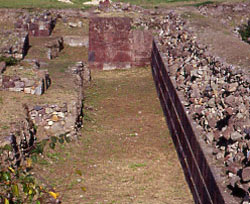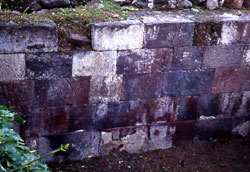
Lipari, the Greek walls and the agger of Sextus Pompeius
The first circuit of walls of Greek Lipàra was erected in the 5th century BC. However, rapid demographic expansion soon made the area it surrounded insufficient. So a new and far larger circuit of walls had to be built in the first half of the 4th century BC (340-300 BC): it almost doubled the urban area, connecting at its two ends the crag of the Castello to the South and that of La Cìvita to the North and running for over two hundred metres in the open plain.
The excavations conducted by Bernabò Brea and Cavalier in 1972 brought to light various long stretches of the rectilinear curtain protecting the city on the plain. The walls were stoutly built; they had a thickness of just under four metres and were faced on both the interior and exterior sides with perfectly ashlared blocks of purplish-red latitandesite from Monte Rosa, laid in isodomic courses; the rubble core of the walls consisted of an èmplekton of very compact small stones.
At least two robust square towers projected from the line of the walls, constructed with the identical technique, to defend the gateways leading into the city.
The new excavation campaign in 1984-1987 in the stretch between the Via Diana and the Vico Scudo revealed the ground level of the siege of 152-251 BC.
Parallel to the Greek walls on their external side, at a distance of some 6 metres, another system of fortification, far coarser in construction, was revealed by the excavations. This was an agger, or rampart, rather than a wall in the proper sense. It was built roughly of drystone rubble and reused blocks. It can be placed in relation to the civil wars between Octavian and Sextus Pompeius (43-36 BC).
Bibliography:
- L. Bernabò Brea, Le fortificazioni greche di Lipari, in Saggi in onore di Guglielmo De Angelis D'Ossat, Istituto di Storia dell'Architettura, Roma 1987, pp. 145-153.
- L. Bernabò Brea M. Cavalier, Meligunìs Lipàra IX.Topografia di Lipari in età greca e romana. Parte II- La città bassa; con allendici di M.A. Mastelloni, E. Messina, G. Ancona, A. Ollà, L. Campagna, U. Spigo, Palermo 1998, pp. 1-409.

